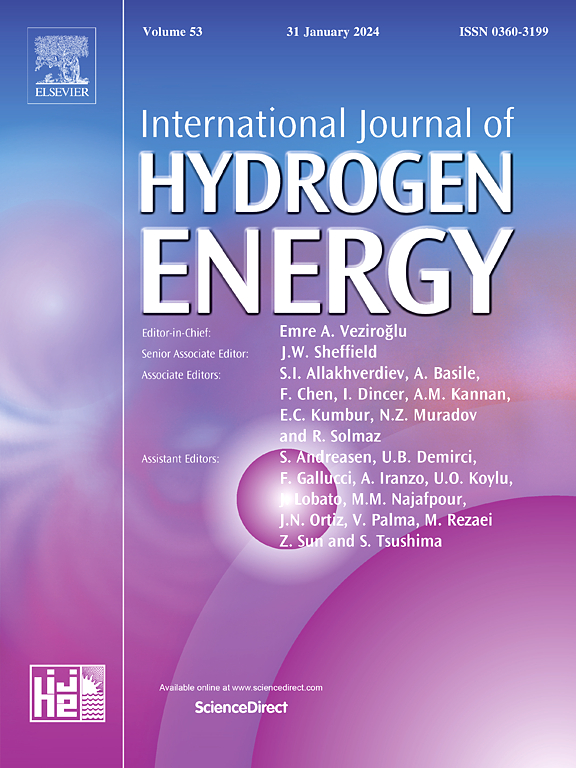Stable bifunctional nanoflower-structured NiMnCu-LDH catalyst for selective and efficient methanol-to-formate electrocatalytic conversion and hydrogen evolution reaction
IF 8.1
2区 工程技术
Q1 CHEMISTRY, PHYSICAL
引用次数: 0
Abstract
Low formate Faradaic efficiency (FE) and poor methanol-to-formate electrooxidation reaction (MOR) stability under high potentials restrict commercialization of coupling MOR with hydrogen evolution reaction (HER), which generates hydrogen and high-value-added formate simultaneously with low energy consumption. Herein, we synthesized a nanoflower-structured NiMnCu-LDH as bifunctional catalyst for both MOR and HER. Adding Cu suppresses oxygen evolution reaction (OER) and elevates Ni3+ content by promoting electron transfer from Ni2+ to Mn3+. NiMnCu-LDH exhibits high MOR activity with potentials of 1.33/1.36 VRHE at 10/100 mA cm−2, high formate selectivity with over 95 % FE at potential exceeding 1.50 VRHE, and superior durability for at least 120 h in alkaline media. Furthermore, NiMnCu-LDH exhibits excellent HER performance with an overpotential of 76.45 mV at 10 mA cm−2 with the existence of methanol. Producing hydrogen and formate is successively achieved by applying NiMnCu-LDH as both anode and cathode simultaneously for methanol electrolysis in a non-diaphragm electrolyzer.

稳定的双功能纳米花结构NiMnCu-LDH催化剂,用于选择性和高效的甲醇-甲酸电催化转化和析氢反应
低甲酸法拉第效率(FE)和高电位下甲醇-甲酸电氧化反应(MOR)稳定性差,限制了MOR与析氢反应(HER)耦合的商业化,该反应可以在低能耗的情况下同时生成氢气和高附加值甲酸盐。在此,我们合成了一种纳米花结构的NiMnCu-LDH作为MOR和HER的双功能催化剂。Cu的加入抑制了析氧反应(OER),并通过促进Ni2+向Mn3+的电子转移而提高了Ni3+的含量。NiMnCu-LDH在10/100 mA cm - 2条件下具有1.33/1.36 VRHE的高MOR活性,在超过1.50 VRHE的电位下具有95%以上的高甲酸选择性,并且在碱性介质中具有至少120 h的耐久性。此外,在甲醇的存在下,NiMnCu-LDH在10 mA cm−2下的过电位为76.45 mV,表现出优异的HER性能。在无隔膜电解槽中,NiMnCu-LDH同时作为阳极和阴极进行甲醇电解,实现了氢气和甲酸的连续生产。
本文章由计算机程序翻译,如有差异,请以英文原文为准。
求助全文
约1分钟内获得全文
求助全文
来源期刊

International Journal of Hydrogen Energy
工程技术-环境科学
CiteScore
13.50
自引率
25.00%
发文量
3502
审稿时长
60 days
期刊介绍:
The objective of the International Journal of Hydrogen Energy is to facilitate the exchange of new ideas, technological advancements, and research findings in the field of Hydrogen Energy among scientists and engineers worldwide. This journal showcases original research, both analytical and experimental, covering various aspects of Hydrogen Energy. These include production, storage, transmission, utilization, enabling technologies, environmental impact, economic considerations, and global perspectives on hydrogen and its carriers such as NH3, CH4, alcohols, etc.
The utilization aspect encompasses various methods such as thermochemical (combustion), photochemical, electrochemical (fuel cells), and nuclear conversion of hydrogen, hydrogen isotopes, and hydrogen carriers into thermal, mechanical, and electrical energies. The applications of these energies can be found in transportation (including aerospace), industrial, commercial, and residential sectors.
 求助内容:
求助内容: 应助结果提醒方式:
应助结果提醒方式:


